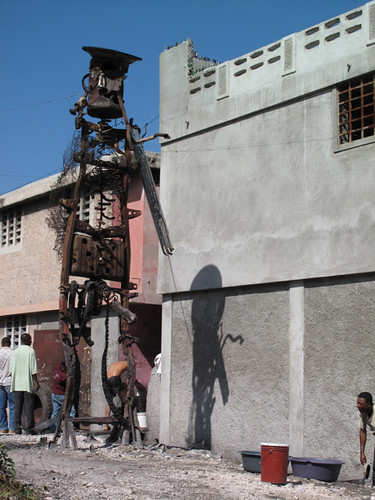Tuesday, November 16, 2010
The Ghetto Biennale
A bustling boulevard in downtown Port-au-Prince seems an unlikely place for an art installation. But, towering over a vacant lot is a 20-foot-tall statue of Legba, the voodoo spirit guardian of the gateway. It’s made out of a car chassis and chunks of a defunct truck. Its creator is André Eugene, one of the sculptors of the Grand Rue.
The Grand Rue is the main avenue that runs north–south through downtown Port-au-Prince. At the avenue’s southern end is a close-knit collective of artists whose sculptural collages of engine manifolds, computer entrails, TV sets, medical debris, skulls and discarded lumber transforms the detritus of a failing economy into deranged, post-apocalyptic totems.
Refused visas, the Grand Rue sculptors were excluded from a private view of their work in a major museum in Miami. A lack of government support makes them economically excluded from all major biennales. In response they organised the Ghetto Biennale.
Rather than bringing completed artworks, as with a traditional biennial, the artists chosen for the Ghetto Biennale created their works in the Grand Rue.
By virtue of its self-organised autonomy, the specificity of the site, and its participatory and relational structure, the first Ghetto Biennale genuinely seemed to disrupt the zones of exclusion entrenched in both contemporary art systems and the geopolitics of the global poor. In this amorphous, chaotic,de-institutionalised space, the distinctions between artist and audience, and between city and gallery appeared momentarily blurred. In the conference which followed, consensus was that a liberated, revolutionary space had emerged.
Subscribe to:
Post Comments (Atom)



No comments:
Post a Comment